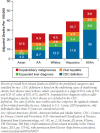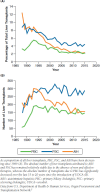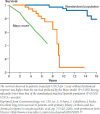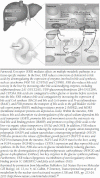Primary Biliary Cholangitis: Medical and Specialty Pharmacy Management Update
- PMID: 27700211
- PMCID: PMC10408407
- DOI: 10.18553/jmcp.2016.22.10-a-s.s3
Primary Biliary Cholangitis: Medical and Specialty Pharmacy Management Update
Abstract
Background: Chronic liver disease and cirrhosis are a leading cause of morbidity and mortality in the United States. Primary biliary cholangitis (PBC), previously known as primary biliary cirrhosis and which has been designated an orphan condition, is a chronic autoimmune disease resulting in the destruction of the small bile ducts in the liver. Without effective treatment, disease progression frequently leads to liver failure and death. Until May 2016, the only FDA-approved treatment for PBC was ursodiol (UDCA), an oral hydrophilic bile acid, which can slow progression of liver damage due to PBC. However, 1 out of 3 patients taking UDCA has an inadequate biochemical response, leading to increased risk of disease progression, liver transplantation, and mortality. Given this unmet clinical need, new therapies are in development for the treatment of PBC. To provide pharmacists with an overview of the latest research on the pathophysiology of PBC and potential new treatment options and to highlight medical and specialty pharmacy approaches to managing access to drugs to treat orphan diseases such as PBC, a 2-hour satellite symposium was presented in conjunction with the 2015 Academy of Managed Care Pharmacy (AMCP) Nexus meeting. Although obeticholic acid was approved by the FDA for the treatment of PBC in May 2016, this development occurred after the symposium presentation. The symposium was supported by an independent educational grant from Intercept Pharmaceuticals and was managed by Analysis Group. Robert Navarro, PharmD, moderated the CPE-accredited symposium titled "Medical and Specialty Pharmacy Management Update on Primary Biliary Cirrhosis." Expert panelists included Christopher L. Bowlus, MD; James T. Kenney, RPh, MBA; and Gary Rice, RPh, MS, MBA, CSP.
Objective: To summarize the educational satellite symposium presentations and discussions.
Summary: Autoimmune liver diseases, including PBC, are responsible for 15% of all liver transplants performed and an equal percentage of deaths related to liver disease. UDCA is the only FDA-approved therapy for treatment of PBC and is considered the standard of care. Nevertheless, many patients do not respond to UDCA, creating the need for new therapeutic options to improve clinical outcomes for PBC patients with inadequate response to treatment. While several agents are being studied in combination with UDCA, monotherapy with the novel agent obeticholic acid, a farnesoid X receptor agonist, has also shown promising results. Health plans are anticipated to assign any newly introduced therapy for the treatment of PBC to specialty pharmacy given its orphan disease status. This assignment enables the health plan to receive disease education, which is particularly important when new drugs are indicated for orphan diseases, and assistance with designing appropriate prior authorization criteria. The clinical value of any new therapeutic options that will inform formulary decisions and prior authorization criteria will be assessed based on evidence of efficacy, safety, and tolerability, among other factors, such as the potential to reduce or delay medical resource utilization (e.g., liver transplant). Key considerations for prior authorization of a new therapy will be determining which PBC patients are appropriate candidates for the new therapy and developing criteria for that determination. These are likely to include clinical diagnostic criteria and degree of response to prior treatment with UDCA. Initially, any new therapy would likely be positioned as noncovered until appropriate prior authorization criteria are established.
Conclusions: PBC is a chronic liver disease with significant morbidity and mortality, as well as a significant burden on the health care system if the disease progresses to the point at which a liver transplant is needed. Although UDCA, the current standard of care, has improved outcomes for many patients, others have an inadequate response to this treatment. This symposium discussed these issues and also addressed the overall treatment paradigm for orphan drug therapies, key implications for patient management, and the role of specialty pharmacy management and any associated needs both in general and specifically for new therapeutic options for PBC.
Figures




Similar articles
-
Obeticholic acid for the treatment of primary biliary cholangitis.Expert Opin Pharmacother. 2016 Sep;17(13):1809-15. doi: 10.1080/14656566.2016.1218471. Epub 2016 Aug 9. Expert Opin Pharmacother. 2016. PMID: 27468093 Review.
-
Long-term clinical impact and cost-effectiveness of obeticholic acid for the treatment of primary biliary cholangitis.Hepatology. 2017 Mar;65(3):920-928. doi: 10.1002/hep.28932. Epub 2017 Jan 17. Hepatology. 2017. PMID: 27906472
-
The British Society of Gastroenterology/UK-PBC primary biliary cholangitis treatment and management guidelines.Gut. 2018 Sep;67(9):1568-1594. doi: 10.1136/gutjnl-2017-315259. Epub 2018 Mar 28. Gut. 2018. PMID: 29593060 Free PMC article.
-
Primary biliary cholangitis: Old and novel therapy.Eur J Intern Med. 2018 Jan;47:1-5. doi: 10.1016/j.ejim.2017.06.020. Epub 2017 Jun 29. Eur J Intern Med. 2018. PMID: 28669591 Review.
-
Old and new treatments for primary biliary cholangitis.Liver Int. 2017 Apr;37(4):490-499. doi: 10.1111/liv.13294. Liver Int. 2017. PMID: 28371104 Review.
Cited by
-
The Clostridium Metabolite P-Cresol Sulfate Relieves Inflammation of Primary Biliary Cholangitis by Regulating Kupffer Cells.Cells. 2022 Nov 26;11(23):3782. doi: 10.3390/cells11233782. Cells. 2022. PMID: 36497042 Free PMC article.
-
Literature Review on Health Emigration in Rare Diseases-A Machine Learning Perspective.Int J Environ Res Public Health. 2023 Jan 30;20(3):2483. doi: 10.3390/ijerph20032483. Int J Environ Res Public Health. 2023. PMID: 36767849 Free PMC article. Review.
-
Intestinal Collinsella may mitigate infection and exacerbation of COVID-19 by producing ursodeoxycholate.PLoS One. 2021 Nov 23;16(11):e0260451. doi: 10.1371/journal.pone.0260451. eCollection 2021. PLoS One. 2021. PMID: 34813629 Free PMC article.
-
Trends in liver transplantation for autoimmune liver diseases: a Canadian study.Can J Surg. 2022 Oct 12;65(5):E665-E674. doi: 10.1503/cjs.012121. Print 2022 Sep-Oct. Can J Surg. 2022. PMID: 36223935 Free PMC article.
-
Statins, Fibrates, and Other Peroxisome Proliferator-Activated Receptor Agonists for the Treatment of Cholestatic Liver Diseases.Gastroenterol Hepatol (N Y). 2020 Jan;16(1):31-38. Gastroenterol Hepatol (N Y). 2020. PMID: 33867886 Free PMC article.
References
-
- Xu J, Murphy SL, Kochanek KD, Bastian BA.. Deaths: final data for 2013. Natl Vital Stat Rep. 2016;64(2):1-119. - PubMed
-
- Kaplan MM, Gershwin M.. Primary biliary cirrhosis. N Engl J Med. 2005;12(353):1261-73. - PubMed
-
- Carbone M, Mells GF, Pells G, et al. .. Sex and age are determinants of the clinical phenotype of primary biliary cirrhosis and response to ursodeoxycholic acid. Gastroenterology. 2013;144(3):560-69. - PubMed
-
- Lindor KD, Dickson ER, Baldus WP, et al. .. Ursodeoxycholic acid in the treatment of primary biliary cirrhosis. Gastroenterology. 1994;106(5):1284-90. - PubMed
Publication types
MeSH terms
Substances
LinkOut - more resources
Full Text Sources
Other Literature Sources
Medical
Research Materials
Miscellaneous

